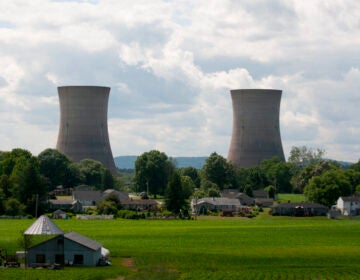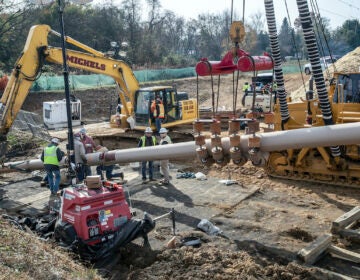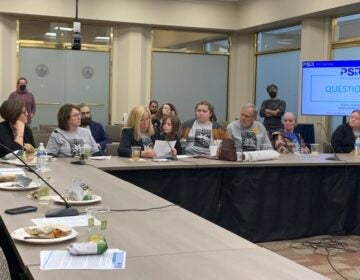Sunoco: Mariner East 2 delayed to 2020, so company will join three pipes as substitute
Company did not immediately say when natural gas liquids would begin moving through the lines.

Mariner East 2 pipeline construction crews work in the backyards of homes on Lisa Drive in West Whiteland Township, Chester County, on May 2. Sinkholes that opened in the area prompted the state's Public Utility Commission to order that an existing pipeline nearby, the Mariner East 1, be shut down until it could be determined that the sinkholes didn't threaten its safety. PUC on May 3 approved a re-start of Mariner East 1. (Marie Cusick/StateImpact Pennsylvania)
This article originally appeared on StateImpact Pennsylvania.
—
Sunoco said late Wednesday it will begin to pump natural gas liquids across the state by joining three new and existing pipes because its long-delayed Mariner East pipeline project won’t be ready for another two years.
The company pushed back the anticipated completion date for the Mariner East 2 and Mariner East 2X pipelines again, this time until the end of 2020 — another major delay to the project that is already at least 18 months behind its original schedule. Sunoco missed its last startup target of the end of September.
The company is building Mariner East 2, a 20-inch pipe, and Mariner East 2X, a 16-inch pipe, to carry natural gas liquids some 350 miles across the state. It had already planned to repurpose an existing 12-inch pipe in Delaware and Chester counties as a temporary part of the Mariner East project. Natural gas liquids are already flowing through Mariner East 1, another older pipeline that runs along the same route as the new lines.
Because of the delay, the company will now use completed sections of new 20-inch and 16-inch pipelines, plus part of the 12-inch pipeline in Chester and Delaware counties, to carry NGLs to a terminal at Marcus Hook near Philadelphia, where most of the material will be exported.
The Public Utility Commission said it does not need to approve specific projects such as the new hybrid pipeline, but that its pipeline safety division ensures compliance with state and federal safety regulations during construction and operation.
“The PUC’s independent Bureau of Investigation and Enforcement will not hesitate to act, with formal complaints or petitions for emergency action, when safety concerns are identified,” said PUC spokesman Nils Hagen-Frederiksen.
Company spokeswoman Lisa Dillinger declined to disclose the capacity of the hybrid line, and did not say when it would start to operate, but said the original planned capacity for Mariner East 2 was 275,000 barrels a day.
She said the “next segment” of the line, also an amalgamation of the three pipes, is due to begin operation in the third quarter of 2019. Meanwhile, the company will continue to build the two new pipelines with a view to having them up and running by the fourth quarter of 2020. Dillinger did not say where the “next segment” of the line would be.
“We will be able to complete both pipelines, fully 20-inch and fully 16-inch, in Q4 2020,” she said.
By using a combination of pipes rather than just a 20-inch pipe for Mariner East 2, as originally planned, Sunoco acknowledged that it will have less capacity than it intended, at least to begin with. But it said it will be able to meet initial customer orders.
“There will be enough capacity to meet our initial customer agreements,” Dillinger said in an email to StateImpact late Wednesday.
The new plans may represent the biggest disruption so far to the cross-state project that has already been beset by technical, environmental and legal challenges since it began construction in February 2017. Regulators and courts have shut down all or parts of the construction at different times because of dozens of spills of drilling fluid and concerns about public safety.
The multi-billion dollar project has continued to generate notices of violation from environmental regulators, as recently as Oct. 16, despite the shutdowns and a $12.6 million penalty earlier this year. The continuing violations fuel opponents’ claims that the project endangers public safety by risking explosions of NGLs in densely populated areas.
Sunoco says its pipelines are safe, and meet or exceed all state and federal regulations. The company reported the industry’s second-highest number of pipeline incidents to federal regulators from 2006 to 2018, according to data from the Pipeline and Hazardous Materials Safety Administration.
As for Sunoco’s planned use of the 12-inch line, which was built in the 1930s, Dillinger did not immediately respond to a question on whether it can safely carry natural gas liquids.
The 12-inch line has a history of leaks, most recently of 33,000 gallons of gasoline into a creek near Philadelphia, and is the focus of growing concern by pipeline opponents that it will leak again, perhaps in densely populated areas.
Del-Chesco United for Pipeline Safety, a community group in Delaware and Chester counties, noted safety risks in its response to Sunoco’s change of plan and said:
“Sunoco’s latest improbable plan, to cobble together sections of an ancient pipe that’s leaked multiple times in Delaware and Chester Counties is unlikely to reassure either impacted communities or investors.”
WHYY is your source for fact-based, in-depth journalism and information. As a nonprofit organization, we rely on financial support from readers like you. Please give today.




